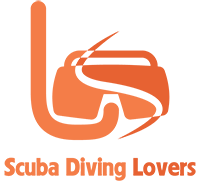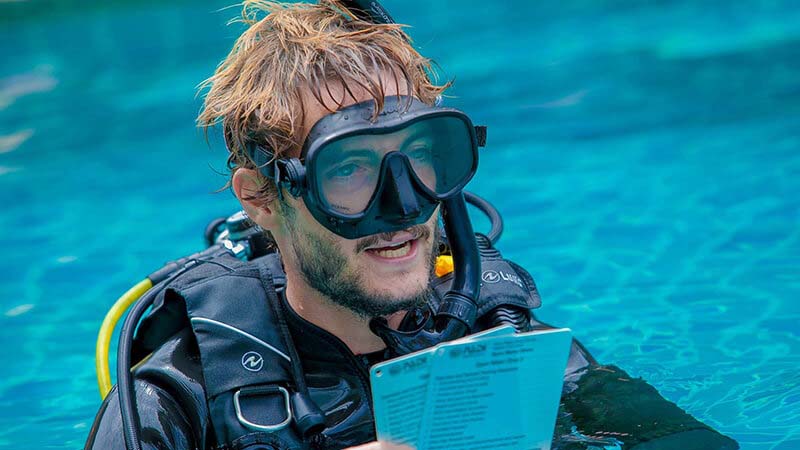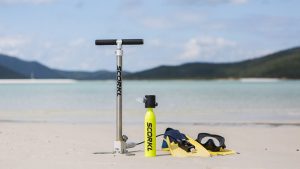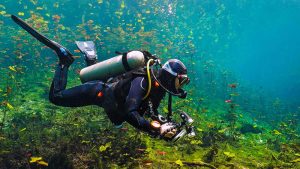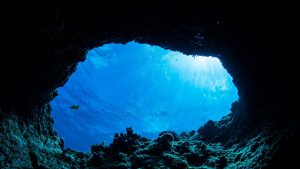What are the main differences and similarities between SSI vs PADI?
For a start, PADI is a diving training and certification agency.
We know that because we discussed it earlier in this article. But then there is SSI scuba retail and training agency. This one has been in the business for close to 5 decades.
To be allowed to dive anywhere in the world, you must first become a proficient diver by acquiring proper training and certifications. A diving certification is attained upon completion of the scuba diving course from any recognized diving agency.
The agency then issues the trained diver with a certification card or the c-card. This card acts as proof that a diver has successfully completed their training. A certified diver can dive or hire any diving gear anywhere around the globe.
But it is not only SSI and PADI that offer scuba certification. Several recognized agencies that certify divers around the world. That dive shop that you see on the beach in Florida could be a certified dive trainer. Mostly, they fall under SSI scuba or PADI.
The WRSTC (World Recreational Scuba Training Council) governs all the scuba training agencies. WRSTC is responsible for setting up the minimum standards for the scuba training programs offered by the certification agencies.
Every scuba diving training agency must be a member of the WRSTC. Among the most popular agencies in the world are SSI, PADI, NAUI and others.
When you train to dive, you can avoid making mistakes that an untrained person would. Diving mistakes could turn fatal easily.
What does SCUBA mean?
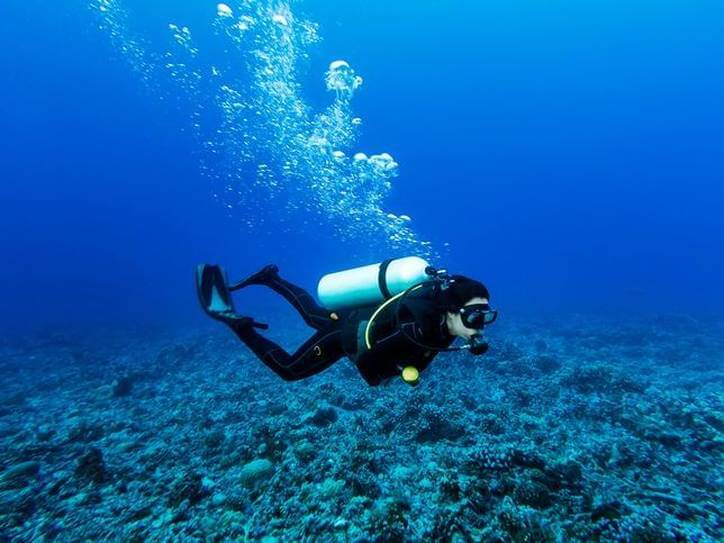
Many beginner diving enthusiasts throw this word around a lot, without knowing its meaning, that is, not knowing that it is an acronym.
It is simple really. It means Self Contained Underwater Breathing Apparatus. This means that scuba is not about freediving, which by the way is not all so popular. It is about the use of diving gear to see how long you can stay underwater.
Today, the terms scuba, scuba diving are associated with the activity of diving below the surface of the water. It is also associated with the use of specialized equipment such as the diving regulator.
As its name suggests, this is a device that regulates the air coming from the tank to your nose. This air is usually pressurized and thus inconsumable in that state. That is why it has to be standardized.
When we say breathing apparatus, this means many things. From the air in the tank, to the regulator, to the scuba diving mask, well, everything must be in working order.
When considering the scuba diving certification cost, consider also that after training, you may have to buy your own diving gear. Buying is better if you are a frequent diver.
However, if you only take one diving holiday a year, well, perhaps renting some of the expensive equipment such as BCD for diving or scuba diving tank would be better.
Clearly, scuba diving is a bit more complex than people think. So what then is the reward? It is in the neutral buoyancy achievement at a certain depth in the water. Of course, this is enhanced by none other than the scuba dive BCD. That, and the contribution to marine biology, oceanography and many more science fields is priceless.
SSI Scuba – Scuba Schools International
SSI is the biggest store-based scuba-training agency in the world. This means that every SSI instructor or professional must be an affiliate of any of their stores or dive centers.
In this case then, a SSI instructor cannot offer scuba diving training as an independent person.
This US based agency was established in 1970. Currently, it has a worldwide representation in over 110 countries. In addition, it boasts of more than 2500 resorts and dive centers around the globe. It also offers printed training materials in over 30 languages. The SSI diving certification is recognized internationally.
PADI – Professional Association of Diving Instructors
PADI is the world’s biggest scuba training organization. This US based agency was formed in 1966.
Currently, PADI has more than 6300 resorts, dive centers, and over 136,000 professional instructors. The PADI certification is also recognized internationally and PADI instructors are allowed to either teach independently or from PADI dive stores.
SSI vs PADI differences and similarities
There are really no major differences between SSI and PADI. This is because the two agencies follow similar basic standards that are set by the regulatory body WRSTC.
The slight differences are mainly on the theory and skills that they teach at different levels. However, despite the minor differences, their training is meant to bear similar results. This is imparting skills that can turn you from a rookie to a competent diver.
Here are some of the main differences and similarities between SSI and PADI.
Flexibility in Training Methodology

While the diving techniques and skills offered by both SSI and PADI do not change, their training methodology differs slightly.
The SSI training methodology is more flexible when compared to that of PADI. For example, PADI courses are set to strictly follow a set sequence. A trainee must first complete level one successfully before they can advance to level two.
If you try to alter the rigid order, you will be breaking their standards. In addition, SSI empowers their instructors to add more skills as long as they improve the quality of the course.
On the other hand, the flow of the SSI course can be changed to suit the needs of a trainee. For example, if a trainee has trouble understanding a certain skill, an SSI instructor is permitted to move to another skill.
Once the trainee has gained enough confidence with another skill, then the instructor can reintroduce the former challenging bit. The SSI uses an 80/20 methodology to teach their students. This means that their instructors are allowed to adapt 20% of the training to suit the student’s pace learning pace.
The course content
Some of the courses offered by the two agencies are very similar while others are quite different. For example, the wreck diving course for SSI is comprised of only two dives. The dives cover navigating on a wreck, important points of interest, using tether line reels and noting hazards.
On the other hand, the PADI wreck diving course features four dives. The dives cover penetration diving, noting hazards, navigating on a wreck and points of interest among others.
Note that penetration diving offered by PADI in this course is not offered by SSI scuba. In order to learn penetration diving with SSI, a student is supposed to undertake an advanced course. This course is known as Extended Range Wreck Diving.
Training Recognition
As we earlier mentioned, both SSI and PADI adhere to the World Recreational Scuba Training Council (WRSTC) standards and guidelines. Both organizations are recognized globally as scuba diving training agencies.
Regardless of the agency that you choose to train with, your certification will be recognized anywhere in the world.
Name of the courses
Names of the courses offered by the two agencies may differ. Even where the course names are similar, the skills learnt and the qualifications required may differ slightly. For instance, the SSI Advanced Open Water level does not equate to the PADI Advanced Open Water level.
Actually, the SSI’s Advanced Adventurer level is the one that is equal to the PADI’s Advanced Open Water level.
Similarly, the SSI Advanced Open Water level is equated to the PADI’s Master Scuba Diver qualification. This means you should be careful when registering for certain courses in one agency and other courses in the other.
Minimum Qualifications
Both SSI and PADI have similar requirements when it comes to the minimum diver’s qualifications. For example, the minimum age requirement for SSI students is 10 years for their open water diving course.
This is the same case with PADI. For one to qualify for the most basic diving course, they have to be at least 10 years of age. However, for one to take online lessons with PADI, they must be at least 13 years of age. This ensures compliance with the international internet laws.
With both agencies, students who are 15 years and below are only recognized as junior level divers. Such students are only allowed to dive down to a certain depth. An instructor must always accompany them. In addition, these students can only upgrade to the next level after they attain the proper age.
Other than the age qualification, both agencies require one to be in good health before being enrolled for any course. A professional medic should carry out tests on you prior the enrollment to confirm that you are not suffering from any major health problem.
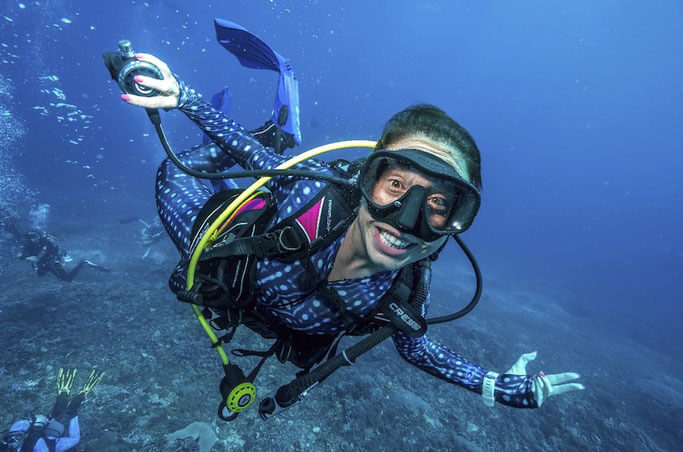
Online Training
Both SSI and PADI offer online learning to their students although the theoretical part only. This reduces the time one spends in a classroom giving the students more time to dive. However, there is a difference in terms of cost, and for how long you can access both platforms.
The SSI scuba online training is free whereas you have to part with about US$ 190 for PADI’s online learning. In addition, the SSI online platform is always there for you even after you complete your course. If you need to refresh your skills later, just login and access what you require.
PADI on the other hand offers their students access to their online platform for a period of one year only after signing up. After the one-year period expires, you need to part with more cash if you need to access their online system.
Cost of training material
When it comes to learning materials, you find some difference in SSI vs PADI training courses. Material does not refer to the gear that you will use for scuba diving (computer). Rather, it refers to lessons themselves.
Apart from online training, both agencies also offer printed materials to their students. However, regardless of the mode of learning, SSI scuba training materials are cheaper than PADI’s.
With SSI scuba, you have the freedom to either buy or borrow the training manuals. This means that it is not compulsory that you buy the manuals. You can borrow theirs and return after you are done with your course.
On the other hand, PADI requires you to purchase your training materials. A student can either buy e-learning materials from PADI’s online platform or the hard manual from any of their stores.
Certification cards
SSI scuba dive centers can process the student’s certifications cards locally. This means that students receive their c-card right after they are through with their course.
SSI divers who complete their training get their certification cards immediately after their course. They don’t have to wait for weeks for their c-cards.
With PADI, their dive centers must firsts submit the student’s certification details to PADI. The student then waits for 90 days before their c-card is processed. In the meantime, PADI issues you with a temporary card, valid for 90 days, which you can use to dive.
Career path
If you wish to become a diving instructor in future, you should probably consider a few things while choosing your agency. For instance, PADI instructors have the freedom to work independently. SSI instructors must work at a dive centre.
However, the SSI instructors benefit from this as they do not pay any annual fees. The PADI instructors on the other hand pay an annual renewal fees every year.
Between SSI vs PADI, which is better?
When it comes to choosing your agency between SSI vs PADI, many people want to know which is the best of the two.
Well, from any resource that you may find online, it would seem as if SSI scuba has more benefits. Not really! Both SSI and PADI have their unique benefits. They also have benefits shared across board.
The truth is that between the two agencies, there is not one scuba diving certification agency than the other. Whether you train with SSI or PADI, the instructors in both agencies are capable of impacting you with the right skills.
The two diving agencies are among the biggest and well known dive organizations in the world. Their certifications have global recognition.
The two organizations may have slight differences as we have already seen. However, regardless of the agency you choose to train with, you will gain the right scuba diving skills.
Therefore, it boils down to your personal preference. You can also choose to train in specific courses with both agencies. The certifications are interchangeable.
Conclusion
You can now be able to make a good decision between SSI vs PADI. Whatever agency you choose to train with, you will reap the license to dive anywhere in the world. Fancy turning that beach vacation into a scuba diving adventure! All you need to do is know how to swim and be of the right minimum age, and you can train for scuba diving certification.
